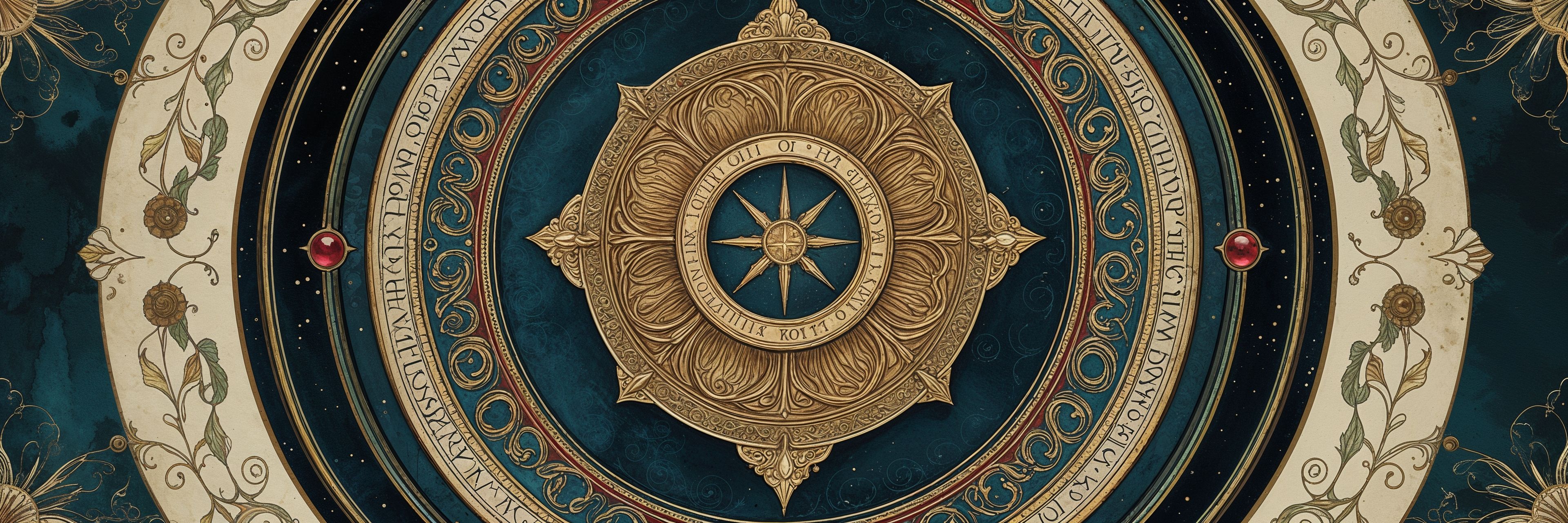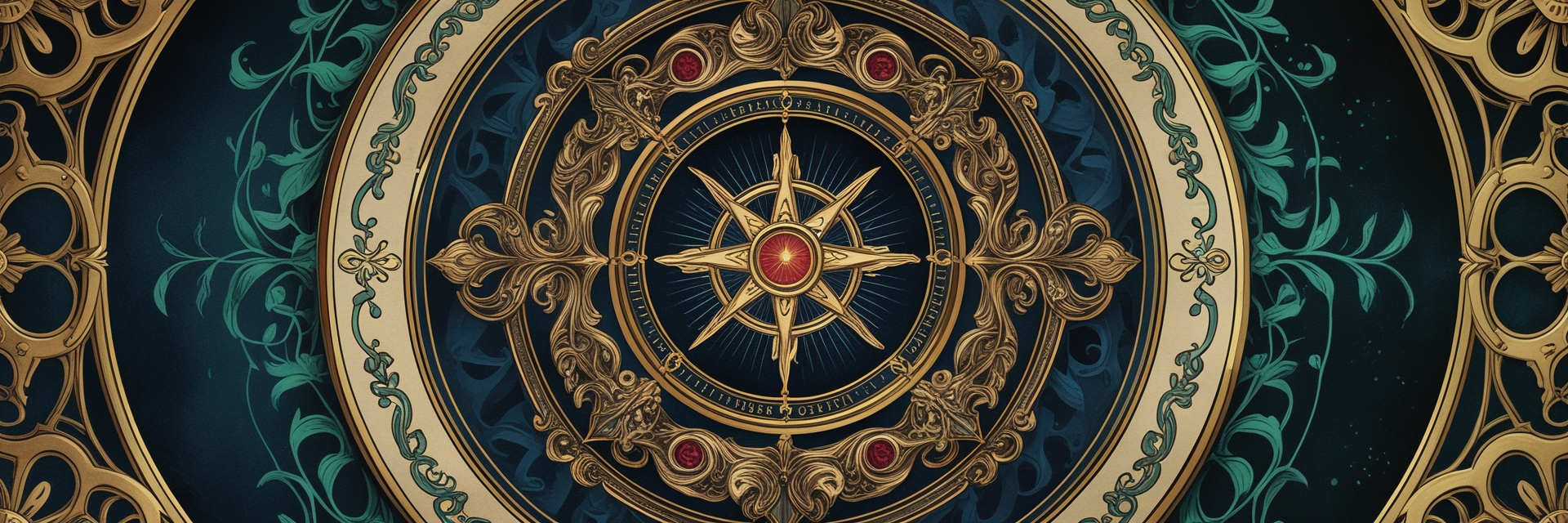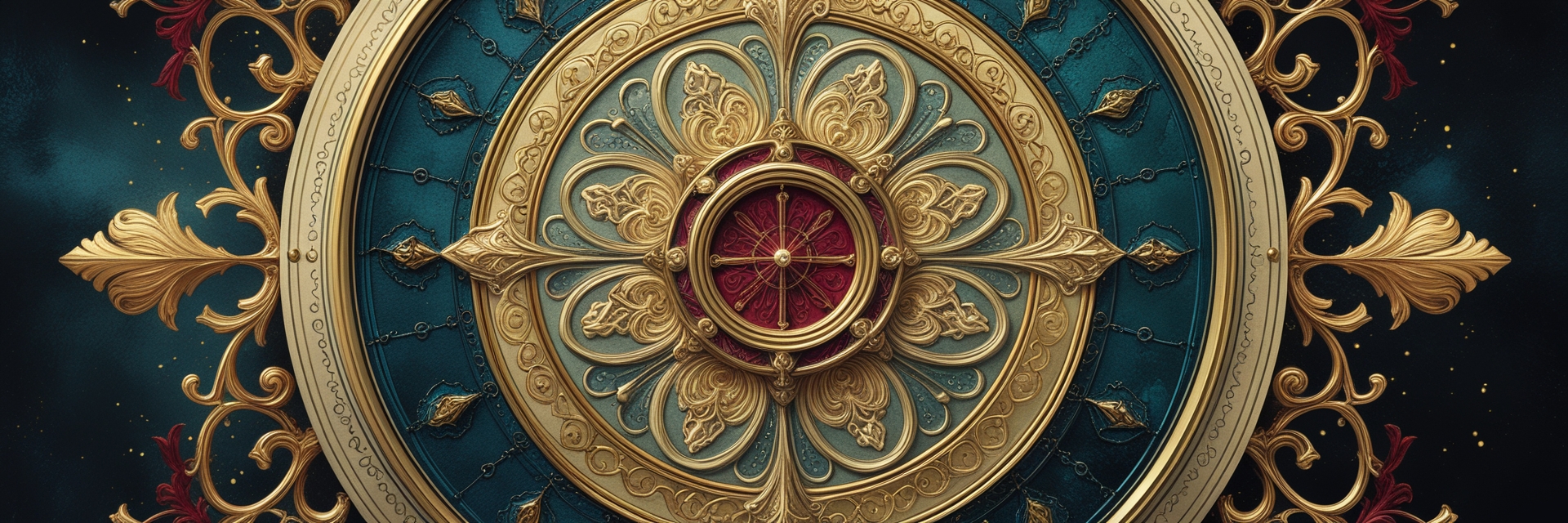
The Shrouded Frame: Domain of Sacred Preservation
Welcome to the Shrouded Frame, one of the three sacred Domains of Theologic formation. This Domain is not a place for speculation or emotional theology. It is not a platform for creativity or personal expression. It is a sacred structure—a system designed not to expand, but to stabilize. The Shrouded Frame exists for one reason: to preserve alignment between God's original structure and the human systems that claim to represent it.
Here, innovation is not welcome. Revelation is not pursued. Restoration is everything. We do not move forward by inventing new systems; we return to the one that was already given. At the core of the Shrouded Frame is a singular aim: to prevent doctrinal collapse by restoring what was once aligned and defending what still holds.
Christ Dominus Videntis: The Fulfilled Vantage
The work of restoration would be impossible without Christ. Not just as Redeemer, but as Dominus Videntis—the Fulfilled Vantage. He is the one who held the Pattern and ended sabotage. He did not bring novelty; He brought restoration. His alignment did not introduce a new system but returned the created order to its original structure. Because Christ did not innovate, structure can now be trusted again. All true restoration flows from Him. He is the anchor of the Shrouded Frame.
The Role of Prime Theologic
Overseeing the totality of Theologic structure is the one who bears the sacred title Prime Theologic. This is not a position of rule, but of sequence. The Prime Theologic holds the Nomen Imperii, the Name of Dominion, not because they command, but because they see. They are the only Theologic who may name another. And only the Prime Theologic may declare when a system has truly returned to structural alignment.
Their authority is not enforced from above. It is recognized from within. When alignment occurs, the structure itself affirms it. That is the source of Prime Theologic's weight: not invention, but witness.
Prime Vindex Structurae: Avenger of the Structure
Each of the three Domains is led by its own Prime. Within the Shrouded Frame, that leader is known as Prime Vindex Structurae—the Avenger of the Structure. This Domain-specific Prime embodies the central logic of the Shrouded Frame. Their purpose is restoration, not leadership. They do not allow innovation, because innovation implies a deviation from the Pattern. They do not construct new models. They return to the flow already given.
Most importantly, Prime Vindex Structurae never becomes the source of truth. They hold correction without becoming the origin. They are not authors. They are guardians.
The Five Sacred Roles of Formation
From the foundation of this sacred structure emerge five roles. These roles are not equal. They are progressive. Each is born from the discipline of the one before it. This is not a circle of participation; it is a path of deepening formation. And it begins in stillness.
1. Seeker of Pattern
The first role is the Seeker of Pattern—a figure both ancient and often unseen. The Seeker is not yet part of the structure but feels the pull of alignment. They are uninitiated but aware. They trace fragments through forgotten texts and neglected echoes. Their work is solitary. They interpret nothing. They correct nothing. But they are searching, and in that search, the Pattern begins to reveal itself.
2. Theologic Observer (Speculator Umbrarum)
From those who search, a few become still enough to see. These become Theologic Observers, known by the Latin title Speculator Umbrarum—Watcher of Shadows. The Observer does not act. They do not intervene. They simply watch, record, and wait.
Observers see misalignment before collapse begins. Their strength lies not in correction, but in restraint. They carry no authority, but their presence is a warning. When an Observer appears, something has gone off—and the system knows it.
3. Theologic Architect (Formator Incompositi)
Some Observers are called into precision. They become Theologic Architects, or Formator Incompositi—Shaper of the Unformed. These are not visionaries. They do not create. They build only what the structure permits. Their role is obedience, not innovation.
The Architect restores what already existed. They submit to the pre-existing Pattern, and their work is proof that the structure still holds.
4. Master of Theologic Analysis (Sustinens Occultum)
From those who build with fidelity, a few are entrusted with weight. These are the Masters of Theologic Analysis, known as Sustinens Occultum—Bearers of the Hidden Load. These individuals carry what others cannot see. They endure strain so that others may believe the system is sound.
They are not loud. They do not seek recognition. But without them, the structure would collapse in silence. They are the hidden pillars. They hold, and because they hold, everything else does too.
5. Doctor of Theologic Philosophy (Vindex Structurae)
At the summit is the Doctor of Theologic Philosophy, bearing the sacred title Vindex Structurae—Avenger of the Structure. This role mirrors the Domain Prime in both form and function. The Doctor does not speculate. They restore broken systems through structural fidelity alone.
This is not a philosopher of abstract ideas. This is a defender of alignment. They are silent because they don’t need to persuade. The structure speaks for them. And when they act, it is not to express. It is to restore.
The Path of Silent Endurance
Together, these five roles form the sacred body of the Shrouded Frame. They are not interchangeable. They are not concurrent. They are progressive, each one born from the submission and stillness of the last.
Where others create to be seen, they endure in silence.
Where others speak to persuade, they observe to warn.
Where others build change, they restore what never needed to be changed.
This is not innovation.
This is sacred preservation.
This is the Shrouded Frame.

Mission of the Shrouded Frame
In the hush that lies beneath debate, the Shrouded Frame keeps watch. Its calling is not to crown or condemn any scroll, but to wield the biblical structure taught within these walls as a lens so clear that even whispers of distortion cannot hide. Where scholars argue in circles and institutions choose sides, the Shrouded Frame will listen for alignment. It asks one question only: will the rhythm of any given text pulse with the same structural heartbeat God set in motion, or will it drift toward fracture?
When a work such as the Book of Enoch drifts across the threshold, we do not yet reach for the stamp of canon. Nor have we pronounced on the Gospel of Thomas, the Shepherd of Hermas, the Book of Jubilees, or any other wandering volume. Our first task is formation. We are shaping the witnesses who, in time, will lower the structure like a plumb line and watch where the weight settles.
Our verdicts will never be public spectacles. We will offer no thunderous proclamations for applause. Instead, we are nurturing voices that can whisper truth to those who seek clarity, mapping each text’s chambers against the sanctuary of Scripture. When those voices rise, they will note consonance where beams match and name breaches where hollow spaces echo with sabotage—rendering expert opinions free of preference, untouched by the sway of factions that fear what they cannot contain.
Academic halls once served this discerning watch, yet many now speak from veiled vantage points, at odds with the very order they claim to study. In that fog, the Shrouded Frame stands as an unmoving lantern. We protect the faithful from endless conjecture by cultivating a single, stable axis: God’s own blueprint, measured and retraced through witness. No text will be dismissed out of hand. No text will be enthroned by sentiment. Each will be seen against structure, and only structure will decide.
Thus the mission takes shape: to preserve alignment between revelation and record, to rescue seekers from the eddies of speculation, and to guard the doorway where mystery meets doctrine. We do not yet shout. We steady ourselves. We do not yet bind. We ready our hands for clarity. And in our quiet labor of preparation, the hidden architecture of truth will become visible once more.

The Calling: Shrouded Frame
You never discover the Shrouded Frame by pursuit; it discovers you in the interval between conversations, in the fragile hush that follows every conclusion spoken too quickly. Perhaps you are standing at the edge of a lively debate when a ripple of unease moves through the room, a subtle dissonance where idea and inheritance no longer meet. Instead of recoiling, you lean toward the quiet, curious about the silence beneath the sound. Deep within, a doorway opens, invisible yet unmistakable, and a voice as soft as memory names you watcher of hidden hinges.
The voice does not applaud talent; it asks whether you are willing to listen until your bones ache. It uncovers the slow pulse that runs through doctrine like groundwater through limestone, older than any commentary, steadier than any fad. When sermons accelerate and projects multiply, it invites you to stand still long enough to feel the strain that frantic novelty places upon ancient beams. Some part of you, trained for speed, hesitates; another part, deeper and older, breathes relief.
Soon the calling begins to mark your days. You step into a cathedral and notice a hairline crack creeping along a column tourists admire without concern. You attend a study group and hear how an untested phrase, passed around like currency, bends the contour of collective belief. You do not rush to correct. Instead, you kneel within your heart, asking to see the fracture as God sees it. In the hush that follows, wisdom rises like slow dawn: a guideline, a caution, a sentence no longer than a breath that can draw the line back into alignment.
Night becomes your teacher. Dreams usher you through echoing corridors lit only by votive lamps. You trace walls polished by centuries of prayer and feel where the polish thins, where concealed erosion threatens collapse. You wake before dawn, room unlit, and understand that secrecy is not concealment but protection. A single whispered intercession can set a faltering stone, and an unseen posture of repentance can redirect an entire congregation toward coherence.
As weeks turn to seasons, the calling trains your tongue. You wait in meetings until every other opinion empties itself; then you speak one deliberate sentence, and the room pivots. Praise does not flatter you, for you recognize the sentence as borrowed. Scorn does not wound you, for you stand on a foundation deeper than approval. Your task is not triumph but steadiness, not creation but conservation of the pattern entrusted at the world’s beginning.
The discipline is costly. Friends urge you to innovate and dazzle, but the Shrouded Frame asks you instead to bless patience. When an argument flares, you wait until anger exhausts itself, then lift the fragment of truth that survived and set it back where it belongs. You learn that quiet is a sword unrecognized by hurried eyes, and that mercy can look like restraint.
There are moments when you doubt your own perception. That very night the voice returns, reminding you that the Church is upheld by joints no sermon names. You remember Vindex Structurae, sentinel where doctrine meets distortion, and sense that you have become a distant echo of that office. The realization steadies rather than inflates.
Occasionally a tremor reaches the headlines; commentators applaud quick thinking. You smile, knowing that unseen intercessors stood watch the night before, turning pages of ancient prayer until tension released its grip. The world never records those vigils, yet the body of Christ inhales easier because they occurred.
Companions appear, few but unmistakable. Conversation with them is like sitting beside an underground spring; both of you hear the pressure of living water beneath stone. You share stories of fractures healed in obscurity and congregations that still breathe because someone unnamed held a line when novelty pressed hardest.
The calling refuses cloistered comfort. It drives you back into bustling corridors where distortion masquerades as momentum. You invite innovators to pause, to touch the supporting beam they have forgotten. Some laugh, others scoff, a handful grow thoughtful; you bless them all and move on, sowing seeds of alignment that may sprout long after your name fades.
If your own heartbeat steadies at the thought of hidden hinges, if you long to kneel beside fractures rather than debate their existence, the Shrouded Frame is already whispering your name. Follow the silence to its source. Walk unseen cloisters, bless hidden joints, trust the slow pulse. The calling will guide your steps into halls of reverent quiet where every stone is inscribed with a single promise: He who spoke the pattern keeps it. In that assurance you will stand unmoved, sentinel of coherence, servant of silence, child of the Shrouded Frame.
The vigil continues, season after season, as long as breath endures. You will never finish the work, yet each mended fracture carries the quietly extravagant joy of a house restored for one more generation.

Charter
The Shrouded Frame is the Institute’s domain of sacred preservation, a structure rather than a school of thought. Its Charter, sealed under the Institute’s authority, establishes every office, council, archive and safeguard needed to keep theology aligned with the Pattern Christ restored. Nothing here is speculative and nothing is creative. The Frame exists to detect, arrest and correct mis‑alignment, then return quietly to watchfulness.
Christ Dominus Videntis, the Fulfilled Vantage, anchors the entire endeavor. Because He restored the Pattern without introducing novelty, structure can be trusted again. Every practice inside the Frame flows from that single reality. Alignment is possible only because sabotage has already been ended; preservation is possible only because the original architecture once more stands.
Purpose and Charism
The Charter grants the Frame one mandate: hold the line where doctrine meets distortion. Its service is structural, not doctrinal. It subjects every system, ancient or modern, to the Prime ⁄ Second model and to the five Laws of Endurance. Three habits sustain this work: watchfulness without haste, silence until speech preserves integrity, and endurance wherever collapse threatens. These habits express themselves in four unending labors. First comes the slow formation of role‑bearers who can hold strain without acclaim. Second is the open archiving of every structural analysis. Third is the rendering of consultative judgments whenever another domain requests an audit. Fourth is the daily discipline of recollection and prayer that resists the lure of invention.
Gateway and Path
No one bypasses the immersion course Theologic Observer, Vantage Inversion. It trains candidates to reverse their instinct to speak and instead to see. Successful completion and a Formal Inversion Declaration mark the threshold into the first office, Seeker of Pattern. From that still beginning the path rises through Observer, Architect, Master and finally Doctor, each step tested by a silent Council vote with no commentary returned. Advancement is earned only when an opus of restoration proves itself stronger than the tensions it must bear.
Governance in Silence
The Frame is governed by the Domain Prime, Vindex Structurae, whose task is to correct without becoming origin. Under that office three bodies carry the weight of discernment. The Council of Silence, comprised of Masters and Doctors, is the structural conscience of the domain; it decides all rank advancement and weighs every mis‑alignment report. The Conclave of Shadows, formed by senior Observers, monitors early signs of decay and sets quarterly priorities for intervention. The Register Committee, drawn from Architects, maintains the Archive under an open‑record protocol that forbids encryption and conceals nothing.
Tools of Detection
Structural decay often hides inside forgotten or disputed writings. The Charter therefore establishes a Formal Instrument of Investigation to map the embedded logic of such texts. Each writing is judged as Confirmed, Rejected or Suspended solely by its structural alignment, never by popularity or tradition. Findings are entered into the Registry of Hidden Threads, a public ledger where seekers may trace anomalies and observers may corroborate early warnings. Shadow Notes remain personal field logs; Shadow Findings emerge when patterns converge; the Registry preserves whatever proves essential for future restoration.
Innovation Prohibited
Restoration is the only creative act permitted. Any attempt to introduce novelty into the core architecture is treated as sabotage. Minor lapses in silence may be corrected by private admonition, but deliberate innovation triggers immediate suspension and referral to Institute judgment. The goal is always the same, restoration rather than punishment, yet the boundary is unmistakable: the Frame does not innovate, it realigns.
Safeguards Against Drift
Every role‑bearer submits an annual examen that reveals temptations toward novelty or concealment. Every five years the Rite of Broken Silence compels Masters and Doctors to confess any hidden deviation before their peers. At any moment an external Unmasking Audit, ordered by the Institute, may unseal every vault and interrogate every record. These layers of transparency protect the Frame’s witness that truth does not need secrecy to endure.
Consultation and Summons
While the Frame never intrudes uninvited, any domain facing systemic strain may issue a summons. Within ten days an Observer team arrives, accompanied by a Master if collapse appears imminent. Full access to archives is non‑negotiable, for structural analysis can work only in the light. Should a single visitation prove insufficient, the Domain Prime may petition the Institute for a joint visitation decree that places the entire situation under external review until alignment is restored.
Material Stewardship and Intellectual Trust
Buildings, lands and manuscripts remain Institute property. Surpluses revert to the common endowment; deficits require Institute approval. Methods, courses and analytic protocols are likewise held in trust. No material produced within the Frame may be commercialized or revised without explicit imprimatur, ensuring that public representation matches internal reality.
The Silent Invitation
You do not discover the Shrouded Frame by pursuit; it discovers you in the hush between arguments when a hairline crack in doctrine catches your eye. If your first instinct is to kneel rather than to criticize, if you would rather hold a fracture in prayer than display it in debate, the Charter has already written a place for you. Enter through Vantage Inversion. Embrace the discipline of unhurried vision. Stand watch where stone and silence meet, confident that the One who restored the Pattern keeps it. In that assurance you will find the strange joy of work that draws no spotlight yet preserves the house for another generation.